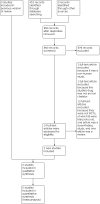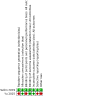Iron chelators for acute stroke
- PMID: 33236783
- PMCID: PMC8095068
- DOI: 10.1002/14651858.CD009280.pub3
Iron chelators for acute stroke
Abstract
Background: Stroke is the second leading cause of death and a major cause of morbidity worldwide. Retrospective clinical and animal studies have demonstrated neuroprotective effects of iron chelators in people with haemorrhagic or ischaemic stroke. This is the first update of the original Cochrane Review published in 2012.
Objectives: To evaluate the effectiveness and safety of iron-chelating drugs in people with acute stroke.
Search methods: We searched the Cochrane Stroke Group Trials Register (2 September 2019), the Cochrane Central Register of Controlled Trials (CENTRAL) (The Cochrane Library 2019, Issue 9; 2 September 2019), MEDLINE Ovid (2 September 2019), Embase Ovid (2 September 2019), and Science Citation Index (2 September 2019). We also searched ongoing trials registers.
Selection criteria: We included randomised controlled trials (RCTs) of iron chelators versus no iron chelators or placebo for the treatment of acute stroke, including subarachnoid haemorrhage.
Data collection and analysis: Two review authors independently screened the search results. We obtained the full texts of potentially relevant studies and evaluated them for eligibility. We assessed risk of bias using the Cochrane 'Risk of bias' tool, and the certainty of evidence using the GRADE approach.
Main results: Two RCTs (333 participants) were eligible for inclusion; both compared the iron-chelating agent deferoxamine against placebo. Both studies evaluated participants with spontaneous intracerebral haemorrhage. We assessed one study to have a low risk of bias; the other study had potential sources of bias. The limited and heterogeneous data did not allow for meta-analysis of the outcome parameters. The evidence suggests that administration of deferoxamine may result in little to no difference in deaths (8% in placebo vs 8% in deferoxamine at 180 days; 1 RCT, 291 participants; low-certainty evidence). These RCTs suggest that there may be little to no difference in good functional outcome (modified Rankin Scale score 0 to 2) between groups at 30, 90 and 180 days (placebo vs deferoxamine: 67% vs 57% at 30 days and 36% vs 45% at 180 days; 2 RCTs, 333 participants; low-certainty evidence). One RCT suggests that administration of deferoxamine may not increase the number of serious adverse events or deaths (placebo vs deferoxamine: 33% vs 27% at 180 days; risk ratio 0.81, 95 % confidence interval 0.57 to 1.16; 1 RCT, 291 participants; low-certainty evidence). No data were available on any deaths within the treatment period. Deferoxamine may result in little to no difference in the evolution of National Institute of Health Stroke Scale scores from baseline to 90 days (placebo vs deferoxamine: 13 to 4 vs 13 to 3; P = 0.37; 2 RCTs, 333 participants; low-certainty evidence). Deferoxamine may slightly reduce relative oedema surrounding intracerebral haemorrhage at 15 days (placebo vs deferoxamine: 1.91 vs 10.26; P = 0.042; 2 RCTs, 333 participants; low-certainty evidence). Neither study reported quality of life.
Authors' conclusions: We identified two eligible RCTs for assessment. We could not demonstrate any benefit for the use of iron chelators in spontaneous intracerebral haemorrhage. The added value of iron-chelating therapy in people with ischaemic stroke or subarachnoid haemorrhage remains unknown.
Trial registration: ClinicalTrials.gov NCT00777140 NCT02216513 NCT02875262 NCT03754725.
Copyright © 2020 The Cochrane Collaboration. Published by John Wiley & Sons, Ltd.
Conflict of interest statement
Lars van der Loo: none known.
René Aquarius: none known.
Onno Teernstra: none known.
Karin Klijn: none known.
Thomas Menovsky: none known.
Marc van Dijk: none known.
Ronald Bartels: none known.
Hieronymus Boogaarts: none known.
Figures
Update of
-
Iron chelators for acute stroke.Cochrane Database Syst Rev. 2012 Sep 12;(9):CD009280. doi: 10.1002/14651858.CD009280.pub2. Cochrane Database Syst Rev. 2012. Update in: Cochrane Database Syst Rev. 2020 Nov 24;11:CD009280. doi: 10.1002/14651858.CD009280.pub3. PMID: 22972139 Updated.
References
References to studies included in this review
Selim 2019 {published data only}
References to studies excluded from this review
Cook 1995 {published data only}
-
- Cook DA, Vollrath B. Free-radicals and intracellular events associated with cerebrovascular spasm. Cardiovascular Research 1995;30(4):493-500. [PMID: ] - PubMed
Harada 1993 {published data only}
-
- Harada T, Luo Z, London S, Gajdusek C, Mayberg M. Antioxidant and iron-chelating agents in cerebral vasospasm. In: Findlay JM, editors(s). Cerebral Vasospasm. Amsterdam: Elsevier, 1993. - PubMed
NCT00777140 {published data only}
-
- NCT00777140. Thrombolysis and deferoxamine in middle cerebral artery occlusion (TANDEM-1). clinicaltrials.gov/ct2/show/NCT00777140 (first received 22 October 2008).
Papadakis 2008 {published data only}
-
- Papadakis M, Nagel S, Buchan AM. Development and efficacy of NXY-059 for the treatment of acute ischemic stroke. Future Neurology 2008;3(3):229-40. [DOI: 10.2217/14796708.3.3.229] - DOI
Selim 2011 {published data only}
References to ongoing studies
ChiCTR‐TRC‐14004979 {unpublished data only}ChiCTR‐TRC‐14004979
-
- ChiCTR-TRC-14004979. The clinical effect of deferoxamine mesylate on edema after intracerebral hemorrhage. www.chictr.org.cn/showprojen.aspx?proj=4595 (first received 20 July 2014).
EUCTR2007‐006731‐31‐ES {unpublished data only}EUCTR2007‐006731‐31‐ES
-
- EUCTR2007-006731-31-ES 2008. Double-blind, randomized, placebo controlled, dose-finding phase II clinical trial of intravenous deferoxamine in patients with acute ischemic stroke treated with tissue plasminogen activator. www.clinicaltrialsregister.eu/ctr-search/trial/2007-006731-31/ES (first received 1 January 2008).
IRCT2013111915444N2 {unpublished data only}IRCT2013111915444N2
-
- IRCT2013111915444N2. Effect of deferoxamine on hemorrhagic transformation of middle cerebral artery stroke. www.irct.ir/trial/14703 (first received 12 November 2014).
NCT02216513 {unpublished data only}
-
- NCT02216513. Deferoxamine to prevent delayed cerebral ischemia after subarachnoid hemorrhage. clinicaltrials.gov/ct2/show/NCT02216513 (first received 15 August 2014).
NCT02875262 {unpublished data only}
-
- NCT02875262. Deferoxamine in Aneurysmal Subarachnoid Hemorrhage Trial (DASH). clinicaltrials.gov/ct2/show/NCT02875262 (first received 23 August 2016).
NCT03754725 {unpublished data only}
-
- NCT03754725. Deferiprone for ruptured brain aneurysm. clinicaltrials.gov/ct2/show/NCT03754725 (first received 27 November 2018).
Additional references
Arthur 1997
Carbonell 2007
Castellanos 2002
-
- Castellanos M, Puig N, Carbonell T, Castillo J, Martinez JM, Rama R. Iron intake increases infarct volume after permanent middle cerebral artery occlusion in rats. Brain Research 2002;952:1-6. - PubMed
Dávalos 2000
Dexter 2011
-
- Dexter DT, Statton SA, Whitmore C, Freinbichler W, Weinberger P, Tipton KF. Clinically available iron chelators induce neuroprotection in the 6-OHDA model of Parkinson's disease after peripheral administration. Journal of Neural Transmission 2011;118:223-31. - PubMed
Dorhout Mees 2007
Duffy 2001
-
- Duffy SJ, Biegelsen ES, Holbrook M, Russell JD, Gokce N, Keaney JF Jr, et al. Iron chelation improves endothelial function in patients with coronary artery disease. Circulation 2001;103:2799-802. - PubMed
Global Burden of Disease Study 2019
Goldstein 2003
-
- Goldstein L, Teng Z-P, Zeserson E, Patel M, Regan RF. Hemin induces an iron-dependent, oxidative injury to human neuron-like cells. Journal of Neuroscience Research 2003;73:113-21. - PubMed
Gu 2009
Halliwell 1984
Hanson 2009
Harada 1992
-
- Harada T, Mayberg MR. Inhibition of delayed arterial narrowing by the iron-chelating agent deferoxamine. Journal of Neurosurgery 1992;77:763-7. - PubMed
Hatcher 2009
Higgins 2011
-
- Higgins JP, Green S, editor(s). Cochrane Handbook for Systematic Reviews of Interventions Version 5.1.0 (updated March 2011). The Cochrane Collaboration, 2011. Available from www.handbook.cochrane.org.
Higgins 2019
-
- Higgins JP, Thomas J, Chandler J, Cumpston M, Li T, Page MJ, et al, editor(s). Cochrane Handbook for Systematic Reviews of Interventions version 6.0 (updated July 2019). The Cochrane Collaboration, 2019. Available from www.training.cochrane.org/handbook.
Huang 2002
-
- Huang F, Xi G, Keep RF, Hua Y, Nemoianu A, Hoff JT. Brain edema after experimental intracerebral hemorrhage: role of hemoglobin degradation products. Journal of Neurosurgery 2002;96:287-93. - PubMed
Ishimaru 1996
-
- Ishimaru H, Ishikawa K, Ohe Y, Takahashi A, Tatemoto K, Maruyama Y. Activation of iron handling system within the gerbil hippocampus after cerebral ischemia. Brain Research 1996;726:23-30. - PubMed
Jennett 1975
-
- Jennett B, Bond M. Assessment of outcome after severe brain damage. Lancet 1975;1:480-4. - PubMed
Lee 2010
Lefebvre 2019
-
- Lefebvre C, Glanville J, Briscoe S, Littlewood A, Marshall C, Metzendorf M-I, et al. Technical supplement to Chapter 4: searching for and selecting studies. In: Higgins JP, Thomas J, Chandler J, Cumpston MS, Li T, Page MJ, et al, editor(s). Cochrane Handbook for Systematic Reviews of Interventions Version 6.0 (updated July 2019). The Cochrane Collaboration, 2019.. Available from: www.training.cochrane.org/handbook.
Li 2008
Mehta 2002
-
- Mehta S, Webb RC, Dorrance AM. The pathophysiology of ischemic stroke: a neuronal and vascular perspective. Journal of Medical Sciences 2002;22:53-62.
Millan 2007
-
- Millan M, Sobrino T, Castellanos M, Nombela F, Arenillas JF, Riva E. Increased body iron stores are associated with poor outcome after thrombolytic treatment in acute stroke. Stroke 2007;38:90-5. - PubMed
Nakamura 2004
-
- Nakamura T, Keep RF, Hua Y, Schallert T, Hoff JT, Xi G. Deferoxamine-induced attenuation of brain edema and neurological deficits in a rat model of intracerebral hemorrhage. Journal of Neurosurgery 2004;100:672-8. - PubMed
Okauchi 2010
Pérez de la Ossa 2010
-
- Pérez de la Ossa P, Sobrino T, Silva Y, Blanco M, Millán M, Gomis M. Iron-related brain damage in patients with intracerebral hemorrhage. Stroke 2010;40:810-3. - PubMed
Prabhu 2009
-
- Prabhu R, Prabhu V, Prabhu RS. Iron overload in beta thalassemia: a review. Journal of Bioscience and Technology 2009;1:20-31.
Prass 2002
-
- Prass K, Ruscher K, Karsch M, Isaev N, Megow D, Priller J. Deferoxamine induces delayed tolerance against cerebral ischemia in vivo and in vitro. Journal of Cerebral Blood Flow and Metabolism 2002;22:520-5. - PubMed
Regan 1996
RevMan Web 2020 [Computer program]
-
- The Cochrane Collaboration Review Manager Web (RevMan Web). Version 1.23.2. The Cochrane Collaboration, 2020. Available at revman.cochrane.org.
Salonen 1998
Sandercock 2008
Selim 2004
-
- Selim MH, Ratan RR. The role of iron neurotoxicity in ischemic stroke. Ageing Research Reviews 2004;3:345-53. - PubMed
Selim 2009
-
- Selim M. Deferoxamine mesylate. a new hope for intracerebral hemorrhage: from bench to clinical trials. Stroke 2009;40(3 Suppl):90-1. - PubMed
Sulter 1999
-
- Sulter G, Steen C, De Keyser J. Use of the Barthel index and modified Rankin scale in acute stroke trials. Stroke 1999;30:1538-41. - PubMed
Vollmer 1991
-
- Vollmer DG, Hongo K, Ogawa H, Tsukahara T, Kassell NF. A study of the effectiveness of the iron-chelating agent deferoxamine as vasospasm prophylaxis in a rabbit model of subarachnoid hemorrhage. Neurosurgery 1991;28:27-32. - PubMed
Wardlaw 2014
Xing 2009
Zaman 1999
-
- Zaman K, Ryu H, Hall D. Protection from oxidative stress-induced apoptosis in cortical neuronal cultures by iron chelators is associated with enhanced DNA binding of hypoxia-inducible factor-1 and ATF-1/CREB and increased expression of glycolytic enzymes, p21 (waf1/cip1), and erythropoietin. Journal of Neuroscience 1999;19:9821-30. - PMC - PubMed
Publication types
MeSH terms
Substances
Associated data
Grants and funding
LinkOut - more resources
Full Text Sources
Medical




